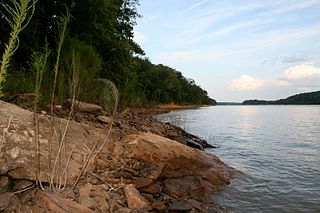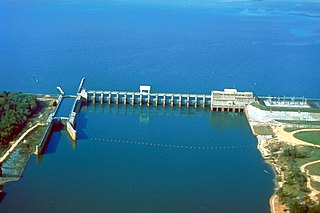
The Seminole Wars were three related military conflicts in Florida between the United States Army and the Seminole, a Native American group which had coalesced in Spanish Florida during the early 1700s. The fighting occurred between about 1816 and 1858, with two periods of uneasy truce between active conflict. Both in human and monetary terms, the Seminole Wars were the longest and most expensive of the Indian Wars in United States history.

Macon, officially Macon–Bibb County, is a consolidated city-county in the U.S. state of Georgia. Macon lies near the state's geographic center, about 85 miles (137 km) southeast of Atlanta—hence the city's nickname, "The Heart of Georgia".

Benjamin Hawkins was an American planter, statesman, U.S. Indian agent, and "a ruthless slave trader". He was a delegate to the Continental Congress and a United States Senator from North Carolina, having grown up among the planter elite. Appointed by George Washington in 1796 as one of three commissioners to the Creeks, in 1801 President Jefferson named him "principal agent for Indian affairs south of the Ohio [River]", and was principal Indian agent to the Creek Indians.

Prospect Bluff Historic Sites is located in Franklin County, Florida, on the Apalachicola River, 6 miles (9.7 km) SW of Sumatra, Florida. The site contains the ruins of two forts

Ocmulgee Mounds National Historical Park in present-day Macon, Georgia, United States preserves traces of over ten millennia of culture from the Native Americans in the Southeastern Woodlands. Its chief remains are major earthworks built before 1000 CE by the South Appalachian Mississippian culture These include the Great Temple and other ceremonial mounds, a burial mound, and defensive trenches. They represented highly skilled engineering techniques and soil knowledge, and the organization of many laborers. The site has evidence of "17,000 years of continuous human habitation." The 3,336-acre (13.50 km2) park is located on the east bank of the Ocmulgee River. Present-day Macon, Georgia developed around the site after the United States built Fort Benjamin Hawkins nearby in 1806 to support trading with Native Americans.

San Marcos de Apalache Historic State Park is a Florida State Park in Wakulla County, Florida organized around the historic site of a Spanish colonial fort, which was used by succeeding nations that controlled the area. The Spanish first built wooden buildings and a stockade in the late 17th and early 18th centuries here, which were destroyed by a hurricane.

Fort Stephenson was built in the early 1800s on the west side of the lower Sandusky River. It was the site in 1813 of an American victory in the Battle of Fort Stephenson during the War of 1812.

Miccosukee is a small unincorporated community in northeastern Leon County, Florida, United States. It is located at the junction of County Road 59 and County Road 151. Miccosukee was a major center of the Miccosukee tribe, one of the tribes of the developing Seminole nation, during the 18th century.

Tugaloo was a Cherokee town located on the Tugaloo River, at the mouth of Toccoa Creek. It was south of Toccoa and Travelers Rest State Historic Site in present-day Stephens County, Georgia. Cultures of ancient indigenous peoples had occupied this area, and those of the South Appalachian Mississippian culture built a platform mound and village here. It was an administrative and ceremonial center for them.

Lake Seminole is a reservoir located in the southwest corner of Georgia along its border with Florida, maintained by the U.S. Army Corps of Engineers. The Chattahoochee and Flint rivers join in the lake, before flowing from the Jim Woodruff Lock and Dam, which impounds the lake, as the Apalachicola River. The lake contains 37,500 acres (152 km2) of water, and has a shoreline of 376 mi (605 km). The fish in Lake Seminole include largemouth bass, crappie, chain pickerel, catfish, striped bass and other species. American alligators, snakes and various waterfowl are also present in the lake, which is known for its goose hunting.

Negro Fort was a short-lived fortification built by the British in 1814, during the War of 1812, in a remote part of what was at the time Spanish Florida. It was intended to support a never-realized British attack on the U.S. via its southwest border, by means of which they could "free all these Southern Countries [states] from the Yoke of the Americans". Built on a militarily significant site overlooking the Apalachicola River, it was the largest structure between St. Augustine and Pensacola. Trading posts of Panton, Leslie and Company and then John Forbes and Company, loyalists hostile to the United States, had existed since the late eighteenth century there and at the San Marcos fort, serving local Native Americans and fugitive slaves. The latter, having been enslaved on plantations in the American South, used their knowledge of farming and animal husbandry to set up farms stretching for miles along the river.
Fowltown Creek, near modern Albany, Georgia, was where "Neamathla's band of Tuttollossees had lived...before relocating down to modern Decatur and Seminole Counties."
Recovery is an unincorporated community in Decatur County, Georgia, United States.
Fort Scott was built in 1816 on the west bank of the Flint River, where it joins the Chattahoochee River to form the Apalachicola, in the southwest corner of Georgia. It was named for Lt. Richard W. Scott, killed in the Scott Massacre of 1817 and never known to have visited the Fort. The need for a fort became evident during the War of 1812, when the British identified this undefended United States border, and in 1814 built two forts on the Apalachicola River, into which the Flint River flows: a strong fort at Prospect Bluff and a smaller one, Nicolls' Outpost, at the river juncture. This was in Spanish Florida, but Spain had neither the resources nor the inclination to do anything about this fort in a location to them remote.
Nicolls' Outpost was the smaller and more northern of two forts built by British Lt. Col. Edward Nicolls during the War of 1812. (The Americans referred to it as Fort Apalachicola. Built at the end of 1814, together with the larger "British post" or storage depot down the Apalachicola, it was "the northernmost post built by the British during their Gulf Coast Campaign". It was just below the Spanish Florida–Georgia border, where the Flint and Chattahoochee Rivers meet to form the Apalachicola, in River Landing Park in modern Chattahoochee, Florida. Even though what was built was smaller than the much larger British post down the Apalachicola, it was intended to be the base, presumably enlarged, for an English invasion of the United States, and British post was to have been its supply depot. The 1815 end of the War of 1812 aborted this project.
The Treaty of Nicolls' Outpost is a little-known treaty between Great Britain and the Red Stick Creek and other refugee Native Americans. Under it, Britain was to recognize the Native Americans as subjects of the Crown, and defend them and their territory from the United States.
The Scott Massacre, coming after the recent (1813) Fort Mims massacre, was a factor convincing the United States that the Creeks must be eliminated, beginning the Seminole Wars. It took place at the end of November, 1817. Several hundred Creek warriors known as Red Sticks, led by Homathlimico, with Josiah Francis in the rear, attacked a vessel commanded by Lieutenant Richard W. Scott. The boat was heading up the Apalachicola River to supply Camp Crawford on the Flint River in southwest Georgia; the attack was at the confluence of the rivers. Besides the supplies, the boat carried 20 sick soldiers, seven women, four children, and a guard of 20 armed soldiers. After a bloody massacre and scalping, only seven survived, one woman, and six soldiers who escaped by jumping into the river and swimming to the opposite shore, where friendly Creeks helped them reach safety at Camp Crawford on December 2, 1817.
The Battle of Ocheesee took place on the Apalachicola River, in northwest Spanish Florida, beginning in December of 1817. The shooting part of the battle lasted almost a week, but the engagement lasted "weeks" and was "the longest sustained engagement of the Seminole Wars". The name comes from the bluffs that overlook the river, from which one party of marksmen waged their attack. Today the land is in Torreya State Park.
Milly Francis, daughter of Creek leader Josiah Francis, was born near what is today Montgomery, Alabama about 1803. Her name is sometimes thought to be an Anglicization of the Creek name "Malee", but the most recent thinking is that "Milly" was her birth name. She was a member of the Red Stick faction of the Creek tribe.
In 1817, during the First Seminole War, Fort Hughes was built on the south side of the Flint River in what is today Bainbridge, Georgia. It was on a bluff at the west end of today's J. D. Chason Memorial Park. Sovereignty over the land between the Flint River and today's border with Florida was an issue; the Battle of nearby Fowltown, November 21–23, 1817, had been over this question. According to the U.S. Government, these lands had been ceded by the Lower Creek Indians in the Treaty of Fort Jackson, whereas the Upper Creeks, also known as Red Stick Creeks or Mikasuki, had not been party to the treaty, did not feel bound by it, and said the land did not belong to the Lower Creeks in the first place. The Fort was intended to prevent further conflict in this region.











